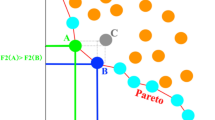Abstract
We consider a quadratic program equivalent to the general problem of minimizing a convex quadratic function of many variables subject to linear inequality constraints.
In previous work [12], one of us presented an algorithm related to such problems, and classified them under “combinatorial equivalence”. The classification contained linear programs at one end (where the function has zero quadratic part) and least-distance programs at the other. A least-distance program is a problem of finding a point of a convex polyhedron which is at least distance from a given point; such programs have been studied by one of us [15, 17] and were shown to correspond to that case of the general problem where the function has positive definite quadratic part.
We now extend the work on least-distance programs to those programs intermediate between linear and least-distance (called “essentially bisymmetric” in [12]), and show that such programs are really “hybrids”, with traits inherited from both parent programs: linear and leastdistance.
Similar content being viewed by others
References
J. Abadie (ed.)Nonlinear programming (North-Holland Company, Amsterdam, 1967).
G. Birkhoff and S. MacLane,A survey of modern algebra (Macmillan Company, New York, 1965) pp. 261–264.
R.W. Cottle and G.B. Dantzig, “Complementary pivot theory of mathematical programming,” 115–136 in [6].
G.B. Dantzig,Linear programming and extensions (Princeton University Press, Princeton, N.J., 1963).
G.B. Dantzig and R.W. Cottle, “Positive (semi) definite programming,” ORC 63-181 (RR) (May 1963), Operations Research Center, University of California, Berkeley. Revised in [1], pp. 55–73.
G.B. Dantzig and A.F. Veinott, Jr. (eds.), “Mathematics of the Decision Sciences, part 1,”Lectures in applied mathematics, Vol. 11 (American Mathematical Society, Providence, R.I., 1968).
W.S. Dorn, “Duality in quadratic programming,”Quarterly of Applied Mathematics 18 (1960) 155–162.
J. Farkas, “Theorie der einfachen Ungleichungen,”J. Reine. Angew. Math. 124 (1902) 1–27.
M. Frank and P. Wolfe, “An algorithm for quadratic programming,”Naval Research Logistics Quarterly 3 (1956) 95–110.
H.W. Kuhn and A.W. Tucker, “Nonlinear programming,”Proceedings of the second Berkeley symposium on mathematical statistics and probability, Ed. J. Neyman (1951) pp. 481–492.
C.E. Lemke, “Bimatrix equilibrium points and mathematical programming,”Management Science 11 (1965) 681–689.
T.D. Parsons, “A combinatorial approach to convex quadratic programming,” Doctoral dissertation, Department of Mathematics, Princeton University, 1966. Revised version inLinear algebra and Applications 3 (1970) 359–378.
A.W. Tucker, “Combinatorial theory underlying linear programs,”Recent advances in mathematical programming, Eds. R.L. Graves and P. Wolfe (McGraw-Hill, New York, 1963) pp. 1–16.
A.W. Tucker, “Principal pivot transforms of square matrices,”SIAM Review 5 (1963) 305.
A.W. Tucker, “A least-distance approach to quadratic programming,” pp. 163–176 in [6].
A.W. Tucker, “Complementary slackness in dual linear subspaces,” pp. 137–143 in [6].
A.W. Tucker, “Least-distance programming,”Proceedings of the Princeton symposium on mathematical programming, Ed. H.W. Kuhn (Princeton University Press, Princeton, N.J., 1971) pp. 583–588.
R.T. Rockafellar,Convex analysis (Princeton University Press, Princeton, N.J., 1970).
Author information
Authors and Affiliations
Additional information
This work was supported in part by Office of Naval Research Contract No. N00014-67-A-0151-0010 (Princeton University).
Rights and permissions
About this article
Cite this article
Parsons, T.D., Tucker, A.W. Hybrid programs: Linear and least-distance. Mathematical Programming 1, 153–167 (1971). https://doi.org/10.1007/BF01584084
Received:
Revised:
Issue Date:
DOI: https://doi.org/10.1007/BF01584084




